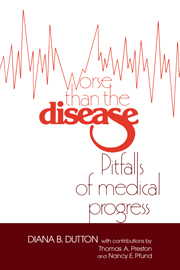Book contents
- Frontmatter
- Contents
- List of contributors
- Preface
- Acknowledgements
- List of abbreviations
- Part I Overview
- Part II Four case studies
- Part III Lessons, questions, and challenges
- 7 Risks and rights
- 8 Compensating the injuries of medical innovation
- 9 What is fair? Medical innovation and justice
- 10 The role of the public
- 11 What is possible? Toward medical progress in the public interest
- Notes
- Index
10 - The role of the public
Published online by Cambridge University Press: 05 May 2010
- Frontmatter
- Contents
- List of contributors
- Preface
- Acknowledgements
- List of abbreviations
- Part I Overview
- Part II Four case studies
- Part III Lessons, questions, and challenges
- 7 Risks and rights
- 8 Compensating the injuries of medical innovation
- 9 What is fair? Medical innovation and justice
- 10 The role of the public
- 11 What is possible? Toward medical progress in the public interest
- Notes
- Index
Summary
The scepticism that I advocate amounts only to this: that when the experts are agreed, the opposite opinion cannot be held to be certain.
–Bertrand Russell, Sceptical Essays, 1928When the Cambridge (Massachusetts) City Council met on January 5, 1977, there were klieg lights, TV cameras, and scores of newspaper reporters. This was no ordinary meeting; it was when Dan Hayes would present the report of the Cambridge Experimentation Review Board – a citizens' panel charged with reviewing the risks of recombinant DNA research, of which he was chairman. Not only would the panel's report determine the future of genetic engineering at two of the world's leading universities, it would also reveal how well a group composed entirely of nonscientists had been able to deal with a complex and highly charged scientific controversy. Such a twist in science policymaking was as unprecedented as the research itself.
The citizens' panel had been appointed by the Cambridge city manager the previous summer, at the height of public alarm about potential hazards of the research. Its seven members were carefully chosen to be broadly representative but, in order to avoid “scientific elitism,” included no practicing scientists. Chairman Hayes ran an oil distribution company in North Cambridge, and the other members included a nurse, two physicians, a nun, a community activist, an engineer, and a professor of urban and environmental policy. Most of the members knew nothing at all about genetic engineering when they began meeting in August, so their sessions were a combination of inquiry and crash course in molecular biology.
- Type
- Chapter
- Information
- Worse than the DiseasePitfalls of Medical Progress, pp. 319 - 349Publisher: Cambridge University PressPrint publication year: 1988

